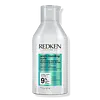What's inside
What's inside
 Key Ingredients
Key Ingredients

 Benefits
Benefits

 Concerns
Concerns

 Ingredients Side-by-side
Ingredients Side-by-side

Water
Skin ConditioningSodium Cocoyl Isethionate
CleansingDecyl Glucoside
CleansingCocamidopropyl Betaine
CleansingSorbitol
HumectantCitric Acid
BufferingHydroxyethyl Urea
HumectantPotassium Hydroxide
BufferingPotassium Cocoyl Glycinate
PPG-5-Ceteth-20
EmulsifyingPanthenol
Skin ConditioningSodium Benzoate
MaskingHydroxypropyl Guar Hydroxypropyltrimonium Chloride
Sodium Chloride
MaskingPEG-55 Propylene Glycol Oleate
Propylene Glycol
HumectantParfum
MaskingCaprylyl Glycol
EmollientAcrylates/C10-30 Alkyl Acrylate Crosspolymer
Emulsion StabilisingPEG-150 Distearate
EmulsifyingPolyquaternium-10
Potassium Cocoate
EmulsifyingCoco-Caprylate/Caprate
EmollientSalicylic Acid
MaskingGlycol Distearate
EmollientButyrospermum Parkii Butter
Skin ConditioningPersea Gratissima Oil
Skin ConditioningLimonene
PerfumingGlycine
BufferingCoco-Betaine
CleansingLinalool
PerfumingTocopherol
AntioxidantHelianthus Annuus Seed Oil
EmollientRosmarinus Officinalis Leaf Extract
AntimicrobialWater, Sodium Cocoyl Isethionate, Decyl Glucoside, Cocamidopropyl Betaine, Sorbitol, Citric Acid, Hydroxyethyl Urea, Potassium Hydroxide, Potassium Cocoyl Glycinate, PPG-5-Ceteth-20, Panthenol, Sodium Benzoate, Hydroxypropyl Guar Hydroxypropyltrimonium Chloride, Sodium Chloride, PEG-55 Propylene Glycol Oleate, Propylene Glycol, Parfum, Caprylyl Glycol, Acrylates/C10-30 Alkyl Acrylate Crosspolymer, PEG-150 Distearate, Polyquaternium-10, Potassium Cocoate, Coco-Caprylate/Caprate, Salicylic Acid, Glycol Distearate, Butyrospermum Parkii Butter, Persea Gratissima Oil, Limonene, Glycine, Coco-Betaine, Linalool, Tocopherol, Helianthus Annuus Seed Oil, Rosmarinus Officinalis Leaf Extract
Water
Skin ConditioningCetearyl Alcohol
EmollientDimethicone
EmollientGlycerin
HumectantBehentrimonium Chloride
PreservativeParfum
MaskingAmodimethicone
Phenoxyethanol
PreservativeCetrimonium Chloride
AntimicrobialIsopropyl Alcohol
SolventSodium Laureth Sulfate
CleansingRicinus Communis Seed Oil
MaskingLactic Acid
BufferingHexyl Cinnamal
PerfumingBenzyl Salicylate
PerfumingLinalool
PerfumingBenzyl Alcohol
PerfumingLimonene
PerfumingAlpha-Isomethyl Ionone
PerfumingCoumarin
PerfumingCitronellol
PerfumingHydroxycitronellal
PerfumingSodium Hyaluronate
HumectantSodium Hydroxide
BufferingGeraniol
PerfumingWater, Cetearyl Alcohol, Dimethicone, Glycerin, Behentrimonium Chloride, Parfum, Amodimethicone, Phenoxyethanol, Cetrimonium Chloride, Isopropyl Alcohol, Sodium Laureth Sulfate, Ricinus Communis Seed Oil, Lactic Acid, Hexyl Cinnamal, Benzyl Salicylate, Linalool, Benzyl Alcohol, Limonene, Alpha-Isomethyl Ionone, Coumarin, Citronellol, Hydroxycitronellal, Sodium Hyaluronate, Sodium Hydroxide, Geraniol
Ingredients Explained
These ingredients are found in both products.
Ingredients higher up in an ingredient list are typically present in a larger amount.
Limonene is a fragrance that adds scent and taste to a formulation.
It's found in the peel oil of citrus fruits and other plants such as lavender and eucalyptus. The scent of limonene is generally described as "sweet citrus".
Limonene acts as an antioxidant, meaning it helps neutralize free radicals.
When exposed to air, oxidized limonene may sensitize the skin. Because of this, limonene is often avoided by people with sensitive skin.
The term 'fragrance' is not regulated in many countries. In many cases, it is up to the brand to define this term. For instance, many brands choose to label themselves as "fragrance-free" because they are not using synthetic fragrances. However, their products may still contain ingredients such as essential oils that are considered a fragrance.
Learn more about LimoneneLinalool is a fragrance and helps add scent to products. It's derived from common plants such as cinnamon, mint, citrus, and lavender.
Like Limonene, this ingredient oxidizes when exposed to air. Oxidized linalool can cause allergies and skin sensitivity.
This ingredient has a scent that is floral, spicy tropical, and citrus-like.
Learn more about LinaloolParfum is a catch-all term for an ingredient or more that is used to give a scent to products.
Also called "fragrance", this ingredient can be a blend of hundreds of chemicals or plant oils. This means every product with "fragrance" or "parfum" in the ingredients list is a different mixture.
For instance, Habanolide is a proprietary trade name for a specific aroma chemical. When used as a fragrance ingredient in cosmetics, most aroma chemicals fall under the broad labeling category of “FRAGRANCE” or “PARFUM” according to EU and US regulations.
The term 'parfum' or 'fragrance' is not regulated in many countries. In many cases, it is up to the brand to define this term.
For instance, many brands choose to label themselves as "fragrance-free" because they are not using synthetic fragrances. However, their products may still contain ingredients such as essential oils that are considered a fragrance by INCI standards.
One example is Calendula flower extract. Calendula is an essential oil that still imparts a scent or 'fragrance'.
Depending on the blend, the ingredients in the mixture can cause allergies and sensitivities on the skin. Some ingredients that are known EU allergens include linalool and citronellol.
Parfum can also be used to mask or cover an unpleasant scent.
The bottom line is: not all fragrances/parfum/ingredients are created equally. If you are worried about fragrances, we recommend taking a closer look at an ingredient. And of course, we always recommend speaking with a professional.
Learn more about ParfumWater. It's the most common cosmetic ingredient of all. You'll usually see it at the top of ingredient lists, meaning that it makes up the largest part of the product.
So why is it so popular? Water most often acts as a solvent - this means that it helps dissolve other ingredients into the formulation.
You'll also recognize water as that liquid we all need to stay alive. If you see this, drink a glass of water. Stay hydrated!
Learn more about Water